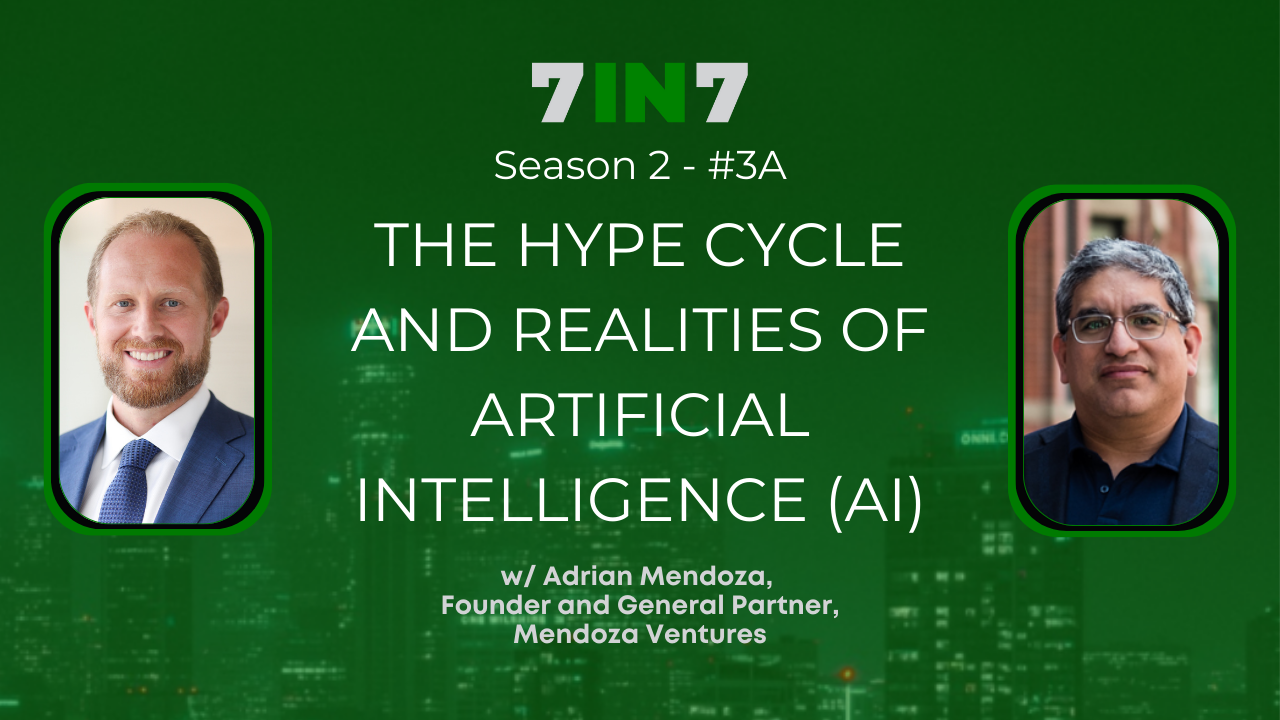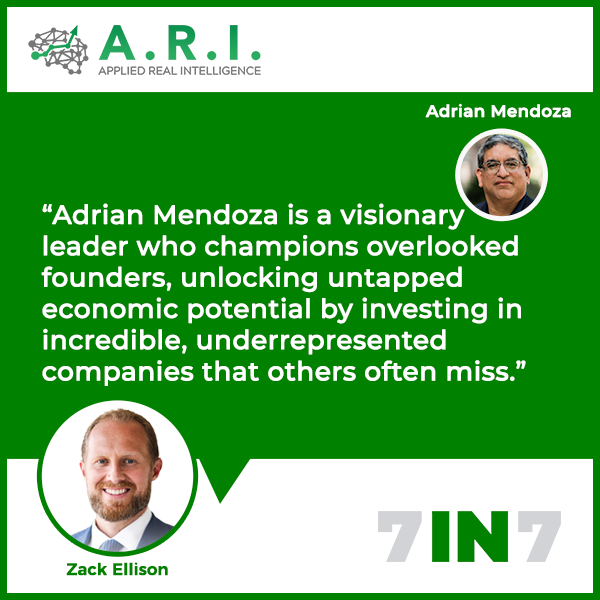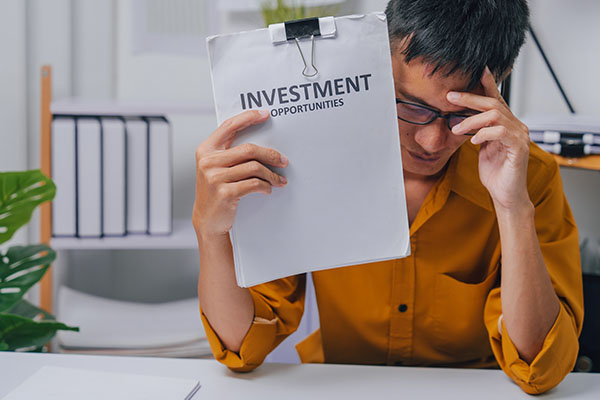
 |
 |
 |
|---|
Watch the episode here
Listen to the podcast here
Adrian Mendoza is the founder and general partner at Mendoza Ventures, which is both Latinx and woman-owned and the first Latinx-founded VC fund on the east coast. His firm focuses on investments in Fintech, AI, and Cybersecurity, with diversity playing an important role in their investment decisions—about 80% of their portfolio consists of startups led by immigrants, people of color, and women.
Since its founding seven years ago, Mendoza Ventures has raised two funds and had two successful exits. The firm is currently raising its third fund, a $100M fintech fund anchored by Bank of America, focused on early growth funding rounds.
In 2022, Axios Magazine listed Adrian as one of the five most influential people in Boston and the LA Times honored Adrian as a DEI visionary as one of California’s most prominent game-changers and thought leaders in the business world today. Adrian is also a regular contributor on CNBC on the state of Venture capital in the US and the firm has recently been covered in Forbes, Bloomberg, and The Boston Globe.
In this episode, Zack Ellison and Adrian discuss:
- Weaknesses of the Power Law Method in VC
- Venture Debt and Equity Synergies
- Benefits of Venture Debt
- The Second AI Hype Cycle
- Cybersecurity and FinTech Opportunities
- Show me the Money! Why Revenue Matters Most
- Ideal Scenarios for Utilizing Venture Debt
The Hype Cycle And Realities Of Artificial Intelligence (AI) With Adrian Mendoza, Part 1
Welcome to the 7in7 Show with Zack Ellison. I’m here with Adrian Mendoza, the Managing General Partner and Founder of Mendoza Ventures in Boston. Adrian, thanks for joining.
Zack, thanks for having me. Just so everybody knows how this hour is going to go down, this is an episode of talking shop and talking sh*t. We’re going to do a little bit of both here, but also to level the playing field, we know Zack in the industry as the captain. We’ll define Zack as the captain for this episode.
Meet Adrian Mendoza
I like it. Tell everybody about yourself and how you got here.
I’m GP at Mendoza Ventures. We started several years ago. My partner and I were both tech founders. We started our first company in 2008 during the GFC. We had an acquisition event in 2015. We had raised VC money ourselves and we said, “I think we can do this better than most of the investors we knew,” and we were right. We kicked off Mendoza Ventures Fund one in 2016. Three years later, we have 10X the capital. We had a successful exit from two diverse founders.
Our first investment in that fund is 20X to 25X because of diverse founders. We went out to market with an early-stage fund. In about 2019, we were run by two operators focused on investing in diverse teams and have done well. That fund two is now marked up by about 1.4X. We went out to market with a fund three that’s a $100 million fund. It’s anchored by some of the top banks in the country, including Bank of America, including a few other banks that you’ve heard of.

The goal is to treat venture capital not like the Power Law method but more like a lower middle market PE shop, very hands-on, very engaged GPs helping with everything from go-to-market strategy to revenue ops, to helping build a team out, building funding syndicates. We now invest in companies that are $1 million to $3 million in revenue. We are predominantly focused on the core strengths that we know, FinTech, AI, and cybersecurity. We are headquartered in Boston and have a satellite office in the Bay Area.
As you know, I’m from Boston, originally. We talked about that.
Good kid from Brookline?
First Latinx-Owned VC Fund
Yeah, a good kid from Brookline, Mass. One of the things that you didn’t mention that I think is relevant is your fund is the first Latinx-owned VC fund on the East Coast, if I’m not mistaken.
You are right. We’re involved with a lot of the Latino GPs, and everything from helping them scale to helping them grow. It started several years ago, when there were very few Black and Brown managers, and it was a lot of the PE GPs that started looking at us and said, “Adrian, you’re the first GP that is Latino and women-owned on the East Coast.” We’re like, “No, we’re not.” We started digging into it and we realized they were right.
Now we have two more small funds in the New York area. For us, we started Mendoza Ventures before there were emerging manager programs and before there were any conversations about what is a diverse emerging manager, Black, pre-George Floyd type of GPs. We have been focused on growing our fund with ourselves, with great LPs that we know, but also investing in spaces that we know ourselves.
We focus on diverse teams because these are fantastic valuations. These are unique individuals who are not the White guys from Stanford but are coming from across the US and are going to have more conservative valuations that are bootstrapping their businesses. Neat venture capital is, for what it’s worth, innovation capital. For us, that’s what makes us interesting and why Zack and I hit it off. We saw the power of what this capital can do from both the venture debt side from the venture capital.
We looked at Zack and were like, “I live in Brookline, he’s from Brookline.” We ended up realizing we could do more partnering together as a venture and venture debt doing things together. That’s where our friendship is from as both professional colleagues of what can we do together, but also how can you use both types of capital to lift diverse founders and female founders to not only sell more of their company but also be strategic in how they do it.
Less than 2% of funding in the VC ecosystem goes to women and minority founders. Share on XYou hit on some interesting points. One fact that a lot of people don’t realize is that less than 2% of funding in the VC ecosystem goes to women and minority founders. It’s shocking to think about 70% of the US population getting 2% of the funding. The way I think about it is it’s not only inequitable, but it’s also economically inefficient. It means there’s an opportunity to make outsized economic returns by creating access for people in those underserved groups.
I think it’s a huge opportunity now both on the equity side and the debt side, because there are a lot of smart founders that have built great businesses, but they don’t have as much access to capital. If you can be that capital provider, you can get better founders and get deals done on very strong terms that are fair to both sides, but also economically very appealing for the GPs.
That’s where the industry is going to head. We’re starting to see a lot more capital look into those spaces. You are the first to launch a Latinx fund on the East Coast. We’re the first venture-debt fund that has a focus on funding diverse founders, including veterans. I’ve talked about this in other episodes where I think there are certain characteristics that founders need to have to be successful.
When you look at someone’s footprint, this is a term that Mike Ryan brought up in a previous episode. Mike ran equities at Goldman. He was a partner there when they IPO and eventually ran $18 billion for Harvard’s endowment. He’s one of the smartest guys I’ve met in the markets. He talks about this idea of a footprint. It’s not necessarily track record where you’re looking at numbers, which is what a lot of investors anchored to, but what has this person and team done over their entire lifespan? What footprint have they left? What obstacles have they overcome, and what characteristics have they demonstrated that would make them more successful in the future?
In other words, are they a good leader? Are they incredibly resilient and persistent? Do they have the vision? If they’ve established that footprint of being able to achieve things in the past while overcoming adversity, that makes them much more likely to be successful in the future. Something that I think we both believe is that there are founders out there that have those characteristics that the market is not being efficient in funding.
It’s what I call internally the long tail of impact. You give dollars to a founder, what do they do with them? Who do they hire? What communities can they affect? You make the business more valuable. You make the asset more valuable. If we come back to asset allocation, what is the inherent value of the asset when so many things are intangible? Being able to add that qualitative aspect to it makes it even more valuable.
I got interviewed by CNBC Asia and they were talking to me about Instacart. I said, “The value of it is it’s a brand that somebody knows. Public sentiment is driving this. Something qualitative is driving a quantitative value.” That’s what we see with these early-stage founders. I don’t invest in underrepresented founders. I invest in overlooked founders. It’s amazing companies that someone is overlooking that are incredible.
I’ve got an Asian American founder off the West Coast, $2.5 million, $3 million in revenue, and has raised zero money. We were first in there, and we’re buying at an incredible price. Our goal is to get him from $3 million to $5 million to $10 million in revenue. My goal is that this company sells in the next 5 to 7 years. It’s an outcome to us and it’s an outcome to LPs. That’s the thing about this business. It’s thinking creatively out of the box to break out of the traditional pattern matching that’s out there in this industry. I’m a big fan that if you continue to invest in the Power Law method, these incredible founders and these incredible companies that no one is looking at will never get invested in. That’s an untapped economic potential.
How would you define the Power Law method for those who don’t know and why it has weaknesses?

Artificial Intelligence: If you continue to invest in the power law method, these incredible founders and companies that no one’s looking at will never get invested. That’s an untapped economic potential.
Power Law Method
It’s because it’s based on statistical significance. If you make 100 investments, 98% will fail, and 2% will be successful. It’s interesting because that’s great when every company is a unicorn. That’s great when everybody’s raising money, but then you have an economy now where no one is raising money, no one is getting an out as an IPO.
The same question was brought up on Instacart and they were like, “Successful IPO.” I’m like, “IPO did a $9 billion valuation. The last round was at $39 billion. It lost 80% of its value. Why are you cheering?” The last-round investors got crushed. They’re lucky to have gotten their money out, if at that. The same is said about this overall industry. When you’re basing it on 98% losses and 2% unicorns, you are losing so much money. When not everyone is raising money, your losses are going to continue to compound.
Our view was completely different. It’s why we look more like a lower middle market private equity shop where we’re only doing 12 companies, not the typical 80 to 100. We’re spending 2 to 3 months on due diligence and we’re looking at outcomes and our IPOs. We’re looking at early acquisitions. Once in a while, there will be a breakout star, but I’m looking at how you create liquidity events in 5 to 7 years.
If you’re doing that, you can’t exist on just traditional sources of venture capital. You can’t think Sequoia or Andreessen is going to come in. We’re looking at everything from mid-market buyouts, lower middle market buyouts, leveraging credit, and leveraging venture debt as alternate funding sources because it’s not going to be your traditional trajectory.
It’s funny. I know an investor in one of our companies. He would talk to me about traditional venture fundraising and he would be like, “There’s the venture and then there’s everything PE does.” He was adamant against alternate sources of funding. He was like, “A good company is only a venture company.” One of his companies had a majority buyout and the next thing you know, he had liquidity.
He still has shares in the company. He’s going to get two bites of the apple. He came to me and said, “Why didn’t you tell me about this?” I’m like, “I’ve been talking about this for years as alternate ways for funding and exits.” He’s like, “Why isn’t everyone doing this?” “It’s because everyone thinks that the Power Law method is you raise money, you keep on raising money, and then you find these unicorns that are then going to have an IPO.
When the IPO market is shot and valuations are 20% of the total, you have to find other funding sources. You have to find other exits.” That’s what we built. Our entire view of our portfolio is let’s find these 5X exits, these 10X exits. In 10 years, I get the same stats as a traditional value fund. Singles and doubles win the ball game. You don’t have to hit a home run.
I agree. That’s our philosophy around venture debt in the sense that if we compound returns at 15% per year conservatively, that means every five years, your money doubles.
At the end of the day, it doesn't matter how much you innovate if nobody cares and nobody wants to buy it. Share on XNot only that, the time horizon for venture is traditionally 16 to 17 years. I don’t have that kind of time. If I can double my money in venture debt in 5 years and then do it again in 10, and then have an acquisition event where you now may have a warrant or you have some liquidity preference, it’s a win-win for everybody. That’s starting from the LP side to start changing the perspective on how you generate liquidity events because they’re not going to be from the market. If it takes 3 to 5 years from opening up. That means these companies are going to stay flat.
We started our new fund. It’s something that I did, I finally had an hour. We were talking about time and doing the work of the fund, which is operations and finance. I went through my schedule investment and I looked at all the markups. For the last couple of weeks, I’ve been telling people, “We’re not investing super early. We’re going to invest in that late-seed series A. We’re going to skip the flatness of the J curve and I’m going to come in right at the elbow.”
I looked at the markups and I looked at TVPI, Total Value Portfolio Investment, and we’re already up by 1.2X and the fund is not even nine months old. I’m like, “I proved it out. That’s it. We can skip the flatness to the J curve.” That’s the power of where both of our funds are coming in. We’re not coming in at the pre-seed or friends and family. We’re coming in when the business has revenue and it’s already popping.
I’ve talked to an LP that was like, “I want to come in at pre-seed of friends and family.” I’m like, “You want to wait 5 to 6 years on the flatness of the J curve, which is death, to finally have something pop by year 6 to 7, and then finally another 10 years. I’m going to skip all that.” That’s the key to where Zack and I find the relationship. Come in a little bit later. You’re still early, but you come in a little bit later when it’s less risky, the business has revenue, and you now have something to anchor both the investment and the debt. It’s much easier to underwrite when you’re not underwriting against something that has no revenue.
Venture Capital
A couple of key themes you touched on. One is this idea of the J curve. The J curve, for folks who don’t know, is when you make an investment in a fund that does venture capital or other types of investments like private equity. The fund manager then has to go out and make those investments and it takes a while to ramp up and they don’t pay off for a while. You’re not making money. In fact, you’re losing money for, oftentimes, anywhere from 3 to 7 years, depending on the type of fund. The expectation is you’ll get a big payoff on the back end of the fund.
What’s nice about your strategy, Adrian, is that you’re coming in. You’re trying to get in a series A where you’re going to get paid off quicker than some of these other seed deals that might take longer. On the venture debt side, what’s great is we don’t have a J curve because as soon as we deploy capital, it’s kicking off money from day one.
A lot of people like that because they want to access innovation as an asset class. I’ve had a couple of investors in our fund say, “The reason I invested is because I love innovation but I don’t have time to wait 10 or 12 years.” I have one guy who’s like, “I might not be alive in ten years and I want to see something like that.” Seriously, he’s like, “I don’t want to leave my kids and grandkids with a bunch of funds that haven’t paid off yet if I can produce you 15% right off the bat,” but also give them that upside through the equity warrants that we get. I think that’s something to think about for folks who want access to innovation, and most people do because that’s where the money is being made. How can you do that? It’s not just through one type of VC investment. There’s a whole bunch of ways to access it.
Everybody knows how venture capital and venture debt work together. They’re complementary. They work together. It’s not like Zack is going to do it by himself. There’s usually that at a funding round. This is where it’s worked tremendously in the past. I had a company that returned 20X to 25X. They carried a venture debt line for years and they never used it. It was more like a safety net. It was a $1 million to $3 million line that sat there. They’re doing tremendously well, $6 million, $9 million in revenue.
People think it’s operating capital, “I’m going to start drawing from it and then work through it,” because they’re at the stage where they’re way too early and they’re drafting from these lines. That’s the danger point. When you do it where the business has revenue, it’s either profitable. It has EBITDA that’s rising, then it’s a complement because if you are a business that’s making $5 million, $10 million in EBITDA and there are vendors that require you to have cash in the bank, great. Use venture debt. You’re not using equity. You’re not selling equity for something you don’t need, and you’re just retaining the capital. That’s the power of it when it is a complement to equity financing.

Artificial Intelligence: It’s much easier to underwrite when you’re not underwriting against something that has no revenue.
What people don’t understand is that as you go later and later in the J curve, the equity is going to get more expensive. The longer you wait, it’s going to be less and less risky. Our view was you don’t have to wait that long. You can just go to Series A or Series B. You’re still getting good valuations, but the risk profile goes less and less. Now you are able to complement it with a venture debt line where you may bring in anywhere from $1 million to $5 million to $10 million. That’s capital sitting on the balance sheet. That is now more attractive to an acquirer to say, “This thing isn’t going to run out of runway. It’s making a profit.” There’s a benefit to having that asset with it.
You touched on some key points. One important thing is that venture debt is for companies that are already doing well. Certainly, at ARI and almost every other venture lender I know, it’s not provided to companies that are struggling and can’t raise equity. It’s provided only to companies that have raised equity very effectively but could use some more growth capital or a little bit of extra liquidity, as almost all insurance, like you said. This capital is used for growth or it’s used for excess liquidity, but it’s a lot cheaper than the equity capital.
Founders love it because the last thing they want to do when they finally become successful after years and years of sweating away at building a company is selling more equity than they need to. Why would you give equity away when you’re about to hit it big? At that point, debt becomes an option because the company is successful. In our case at ARI, the minimum revenue we’re looking at is $10 million per year with a lot of growth expected. In most cases, the deals we’re looking at right now are anywhere from $30 million to $100 million in revenue. These aren’t like two guys on a laptop and a puppy dog in a garage saying, “Maybe one day we can make a buck.”
That’s where I love where you guys are playing. It is because you’re doing it to support a company that’s already profitable. There’s no risk involved in it in the risk profile.
Key Trends
Let’s take a half step back and move to some bigger themes on the venture side. I meant to ask this before we even got going, but I wanted to ask you what you think are the key themes now and trends that you’re seeing broadly when it comes to VC and innovation. If somebody came to you, a potential investor, and said, “Adrian, what’s going on in VC these days? Where are their opportunities? What should I be investing in? What should I be afraid of? Where are the risks,” what would you tell them?
When you look at the life cycle of a venture, a lot of traditional LPs use the barbell method. I’m going to call the dumbbell method. I’m going to come in super early and then I’m going to come in super late. On the late side, how’s that going for you? Not access to any way out. The super early is at the beginning of the J curve. You and I are both sitting in the middle where there’s this massive opportunity for companies that are innovating, that are creating revenue.
The thing everyone doesn’t understand is that great companies are still raising money. The great funds are still raising money. There’s so much innovation that continues to happen. This is just a clearing out of the garbage that’s out there in the landscape. I’m a big believer that whatever is happening in the economy is going in both of our favor because that middle is where the sweet spot is. That’s where the meat is on the bones. Within there, you look at the sectors that are exciting, everything from where we’re playing. Economies are going down, fraud is exploding.
Cybersecurity. We’re talking about how deregulation in the last couple of years has led to wacky things like cryptocurrency, which didn’t fare well for anyone, but what it left in its wake was decentralized finance. That’s going to be a whole ability where a FinTech can start selling products, changing money, and remittances without ever using any PayPal, Visa, or MasterCard. We’re going to see this explosion in taking down the incumbents because there will be no fees in decentralized finance. You can build a company or you can build an app without ever having to pay a single cent because you can use blockchain tokenization to make money.
A lot of the startups fail because they're not thinking that the capital is there as a tool, they think it's just always going to be there. Share on XAt the same time, there’s a lot of excitement in AI, but this is the second coming of AI. We saw one in early 2014, 2015. I call this the second hype cycle and you’re seeing AI on everything. This is a key where, as an LP, if you’re going to use a manager, use one that knows the space, that has a history in this space and that could look through the BS of what’s real and what’s not real. Now we look at everything. We’re seeing everything has AI. We got everything.
My favorite deck was restaurants and AI. I’m like, “Okay.” It was a deck full of pizzas and the computer vision of AI will tell us whether or not there’s too much pepperonis or not enough pepperonis. I’m like, “Who cares? It’s a $0.26 pepperoni if even that. Why are you raising at a $20 million valuation?“ After certain slides of pepperoni, you move on and are like, “Not everything needs AI.” The reality is innovation is going to happen in spaces that are untouched, and finding spaces where, with or without AI, they still require innovation.
That’s where the ability to make money and the ability to generate alpha is putting bets on both companies and managers that could look beyond the hype and look at where actual revenue is being generated. At Mendoza Ventures, we’re a revenue-driven shop. Do you want to prove to me whether or not technology is real? Show me the revenue. Do you want to tell me whether you have customer traction? Show me the revenue. Do you want to tell me whether or not you’re building innovation? Show me the revenue.
At the end of the day, if you can’t get over that million-dollar threshold of true revenue, you may or may never have anything because that’s what it comes down to. Can you sell something that people want to buy? How are you going to get to that $10 million of EBITDA that Zack is looking for? Show me the revenue. That’s the key piece of this. At the end of the day, it doesn’t matter how much you innovate it. Nobody cares and nobody wants to buy it. Did you actually innovate anything?
I’m still laughing about the pizza comment.
That is the craziest one. We see everything because we’re still in the early stage of the innovation spectrum. The pizza one was on my deck of wacky decks.
I should start sending you some that I get. I probably get ten decks a week that say they’re leveraging AI in some way. The first question I always ask them is, “Who on your team has expertise in AI and what is that expertise?” It’s crickets.
It’s cyclical. We see it. We see multiple hype cycles on different things. LPs will talk to us about the market and we’re like, “No, we sit outside of it.” We see trends and they’re cyclical. There’s a trend and everyone rushes to it and then the next trend. People tell us, “How do you find the winners?” I’m like, “The ones that are making money.” It’s as simple as that. It’s a scorecard. Did you not make dollars? Not only that. Some people could do it once. People that could hit $1 million once and then you go and be like, “Great, can you do it again or is this just a one-off?”
That’s the key important thing. That’s what it takes to look at the space and talk to the customers. Heaven forbid we do something unheard of in this business, we call the customers, “Tell me why you bought it. Tell me what your contract looks like. Tell me how much money it saved you.” At the end of the day, if you don’t have that and you can’t get a reference, this is market analysis due diligence 101. “You sold something. Let’s talk to them. Let’s see if you could sell it again.”

Artificial Intelligence: There’s just this massive opportunity for companies that are innovating that are creating revenue.
It’s pattern matching. Can you take this pattern and do it over again? Can you keep on making more money? Can you scale? If so, what’s your year-over-year growth?” You can stay flat but the power of VC dollars is not to build a business. It’s to grow a business. That’s the distinction that everyone forgets. It is early growth capital. A lot of people, especially now, think that VC is philanthropy. It’s not. It’s there to build innovation because if you’re not scaling the business and you’re not hiring and you don’t have 5, 10 families that are growing it and building that wealth out of there, you have nothing there. It’s not designed for a science project. It’s not designed for building tools. It’s designed to spur the economy in this country.
Funding Environment
You touched on a lot there. I want to take a half step back. Summarizing the key trends right now that we are seeing, a couple of things you didn’t touch on. Most people know, but it’s worth reiterating, that it’s very hard to raise capital as a startup right now. Could you talk a little bit about the funding environment for startups and what that means in terms of opportunities for those who are in the space?
It’s funny because the first time I raised money in 2008 and 2009, nobody was raising money. What you have to understand is there’s $290 billion sitting on the sidelines. In 2008 and 2009, there was no money sitting on the sidelines. Every asset class had been affected by toxic mortgages. Every bond, every stock, every portfolio that was in there, there was no capital. Funds are sitting on the sidelines right now and not deploying in the last 18 months to 2 years because they’re waiting. At a certain point, that has to break. When you have that situation of people not deploying, then you have to re-look at your situation as a direct investment, as a startup, and look at it and say, “How am I going to pitch the business?”
I remember when I first pitched my first business, I would go to investors and say, “I’m not going to pitch you. I’m going to come back when I have a customer and I have a working product and I should have a clear path to revenue.” They were like, “I’m shocked.” That’s how it should be. That’s the expectation of a founder. The days of hitching when you have an idea and a PowerPoint are gone. I hope they die this time around.
It’s cyclical. It comes back. It’s coming in with a plan and existing customers, and showing that you are going to hit your metrics, and that you have a strategy, and VC money is there to help you grow. That’s the key to it. I go back to that critical point of the capital should be there. It should be catalytic. It should be there to start the fire and continue to burn it, not to design a product or think about a product. That’s where a lot of the startups fail because they’re not thinking that the capital is there as a tool. They think it’s always going to be there. When it disappears, that’s why we’re seeing gaps in the market but the good founders are still investing. The good founders are still getting investment. The good founders are still building companies with or without the capital.
Important Links
- Zack Ellison on LinkedIn
- Applied Real Intelligence (A.R.I.)
- 7 in 7 Show with Zack Ellison on Apple
- 7 in 7 Show with Zack Ellison on Spotify
- 7 in 7 Show with Zack Ellison on YouTube
- 7 in 7 Show with Zack Ellison on Amazon Music
- Adrian Mendoza on LinkedIn
- Mendoza Ventures
- 7 in 7 Show Disclaimer
About Adrian Mendoza
 Adrian is the founder and general partner at Mendoza Ventures which is both Latinx and woman-owned and the first Latinx-founded VC fund on the east coast. His firm focuses on investments in Fintech, AI, and Cybersecurity, with diversity playing an important role in their investment decisions—about 80% of their portfolio consists of startups led by immigrants, people of color, and women. Since its founding seven years ago, Mendoza Ventures has raised two funds and had two successful exits.
Adrian is the founder and general partner at Mendoza Ventures which is both Latinx and woman-owned and the first Latinx-founded VC fund on the east coast. His firm focuses on investments in Fintech, AI, and Cybersecurity, with diversity playing an important role in their investment decisions—about 80% of their portfolio consists of startups led by immigrants, people of color, and women. Since its founding seven years ago, Mendoza Ventures has raised two funds and had two successful exits.
The firm is currently raising its third fund, a $100M fintech fund anchored by Bank of America, focused on early growth funding rounds. In 2022, Axios Magazine listed Adrian as one of the five most influential people in Boston and the LA Times honored Adrian as a DEI visionary as one of California’s most prominent game-changers and thought leaders in the business world today.
Adrian is also a regular contributor on CNBC on the state of Venture capital in the US and the firm has recently been covered in Forbes, Bloomberg, and The Boston Globe.
The Mendoza family just recently launched Mendoza Impact a philanthropic initiative to help fund diverse and female founders and fund managers.